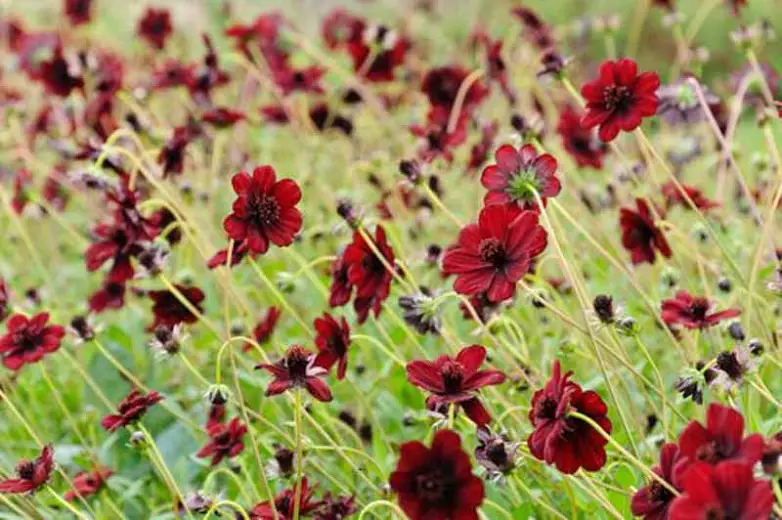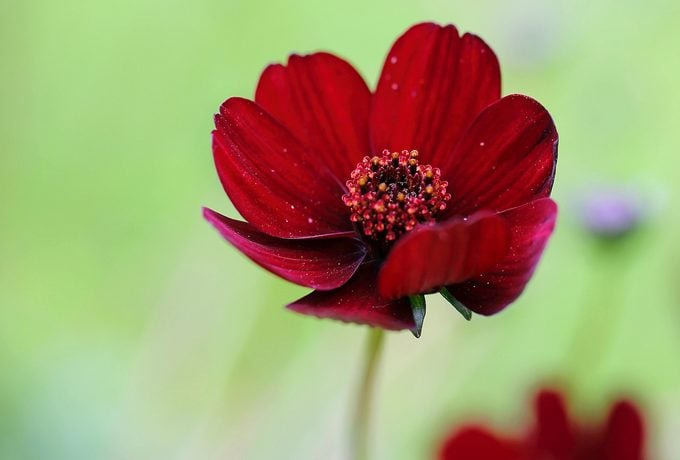Chocolate cosmos is a beautiful perennial plant that produces dark, velvety red flowers with a distinct chocolate scent. The plant is native to Mexico and is a member of the Asteraceae family. Growing chocolate cosmos requires careful attention to soil, water, and sunlight, as well as proper care of the plant. In this blog post, we will discuss how to grow chocolate cosmos in detail.

Choosing the Right Location
The first step in growing chocolate cosmos is to choose the right location. The plant requires a sunny location with well-draining soil. The ideal location should receive at least six hours of sunlight each day. The soil should be well-draining, as chocolate cosmos does not tolerate wet feet. If the soil is heavy or compacted, it is important to amend it with organic matter such as compost, peat moss, or aged manure. This will help to improve drainage and provide the plant with the nutrients it needs.
Planting Chocolate Cosmos
Once you have chosen the right location, the next step is to plant the chocolate cosmos. The best time to plant chocolate cosmos is in the spring, after the last frost. Before planting, it is important to prepare the soil by removing any weeds or debris and adding organic matter.
To plant chocolate cosmos, dig a hole that is slightly larger than the root ball of the plant. Place the plant in the hole and backfill with soil, making sure that the top of the root ball is level with the soil surface. Water the plant well after planting.
Watering Chocolate Cosmos
Chocolate cosmos requires moderate watering. The plant should be watered when the top inch of soil is dry. Overwatering can cause root rot, so it is important not to let the plant sit in water. On the other hand, underwatering can cause the plant to become stressed and wilted.
One way to ensure that chocolate cosmos receives the right amount of water is to mulch around the plant. Mulching helps to retain moisture in the soil and also helps to suppress weeds.
Fertilizing Chocolate Cosmos
Chocolate cosmos does not require a lot of fertilizer. However, a light application of fertilizer in the spring and again in mid-summer can help to promote healthy growth and blooming. A balanced, all-purpose fertilizer can be used, or a fertilizer specifically formulated for flowering plants.
It is important not to over-fertilize chocolate cosmos, as this can lead to excessive vegetative growth at the expense of blooming.
Pruning Chocolate Cosmos
Chocolate cosmos benefits from regular pruning. Deadheading spent blooms will encourage the plant to produce more flowers. It is also important to remove any diseased or damaged leaves or stems, as these can harbor pests and diseases.
At the end of the growing season, chocolate cosmos should be cut back to a few inches above the ground. This will help to prevent the plant from becoming too woody and also helps to stimulate new growth in the spring.
Propagating Chocolate Cosmos
Chocolate cosmos can be propagated by division or from seed. Division is the easiest and quickest method. To propagate by division, simply dig up the plant in the spring or fall and separate the clumps into smaller sections. Replant the smaller sections and water well.
To propagate from seed, collect the seeds from the plant in the fall and store them in a cool, dry place until the spring. In the spring, plant the seeds in a seed tray or directly into the garden soil.
Common Problems and Solutions

Like all plants, chocolate cosmos is susceptible to pests and diseases. The most common pests that affect chocolate cosmos are aphids, spider mites, and thrips. These pests can be controlled with insecticidal soap or neem oil spray.
Another problem that can affect chocolate cosmos is powdery mildew, a fungal disease that causes a white, powdery coating on the leaves. This can be prevented by providing good air circulation around the plant and avoiding overhead watering.
If powdery mildew does occur, it can be treated with a fungicide or by removing the affected leaves. It is also important to avoid planting chocolate cosmos in a location where powdery mildew has been a problem in the past.
Growing chocolate cosmos can be a rewarding experience for gardeners who are looking for a unique and beautiful addition to their garden. By following the tips outlined in this blog post, you can ensure that your chocolate cosmos thrives and produces a stunning display of dark, velvety red flowers with a distinct chocolate scent. Remember to choose the right location, plant correctly, water and fertilize properly, prune regularly, propagate as desired, and watch out for common problems. With proper care, your chocolate cosmos will flourish for years to come.


















